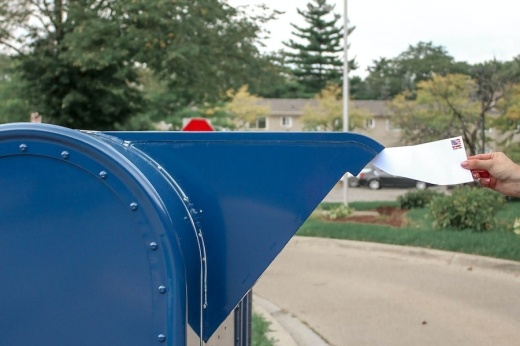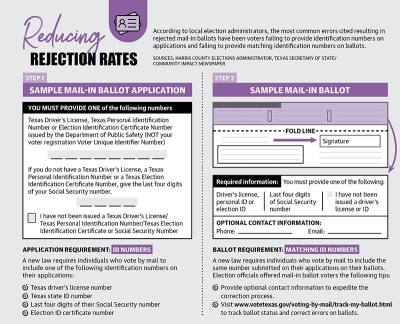In south Houston counties during the primaries, Brazoria County rejected 5.71% of mail-in ballots, or 135 ballots, and Galveston County rejected 12.37%, or 435 ballots.
The percentage of rejected mail-in ballots dropped in the following May runoff elections as election officials adapted to new guidelines as well as eligible mail-in voters, who must be either at least 65 years old, sick, disabled, out of the country or other criteria.
“We were able to adapt,” Brazoria County Elections Clerk Susan Cunningham said. “It was a lot of learning; there are a lot of new forms if we have to mail it back to the voter.”
Effects of the bill
One of the new requirements from SB 1, the voting reform bill, requires officials to compare a voter’s personal information on their application for ballot by mail and their voter registration record. The application can be rejected if the voter’s driver’s license number or Social Security number cannot be verified with the voter’s registration form, causing the ballot to need to be “cured” by the voter.
Cunningham said the spike in rejections was caused by people forgetting if their driver’s license number or Social Security number was provided on their voter registration. She recommended voters put both of their personal ID numbers on their application for a better chance of matching their voter registration form.
“What happened a lot, I believe, was people had their driver’s licenses in their voter registration,” Cunningham said. “Well, maybe they aren’t driving anymore once they got older, and so now they have a Texas ID number. So they put their new Texas ID number on the envelope, and that’s not in the voter registration.”
Galveston County Clerk Dwight Sullivan said the county is small enough for election officials to successfully reach more voters with mail-in ballot issues than a larger county such as Harris County.
“In the March 1 primary, we had a higher rejection rate than we did in the runoff, so you will see that people kind of learned the system pretty quick,” Sullivan said.
Adapting to new rules
After the unprecedented spike in mail-in rejections in March, counties saw a smaller percentage of rejected ballots in the following elections. During the May 7 uniform election, 5.02% of mail-in ballots were rejected statewide, and 3.9% were rejected during the May 24 primary runoffs.
Sullivan said the Texas secretary of state’s office will send voters pamphlets and set up billboards ahead of the November elections to prepare voters for changes to voting rules and help maintain low mail-in ballot rejections. He said people whose mail application was rejected in many cases can go online to www.votetexas.gov to address their issue.
Many voters in Brazoria and Galveston counties will see new hybrid paper and digital machines at polling stations in November since the state mandated a return to paper. Sullivan said voters may expect to see long lines in Galveston County at the beginning as people get used to the new method.
Cunningham said the voter interface in Brazoria County will not change, but once candidate selections are made, the voter will then scan the paper copy of their ballot. She said the voter can check their paper ballot and correct any mistakes if needed.
“If [voters] walk out with that piece of paper [without scanning], their vote doesn’t count. They haven’t actually finished the process,” Cunningham said. “That’ll probably be the learning curve.”
Emily Lincke and Wesley Gardner contributed to this report.







